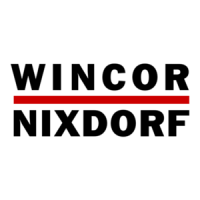
Do you have a question about the Wincor Nixdorf L2 and is the answer not in the manual?
| Brand | Wincor Nixdorf |
|---|---|
| Model | L2 |
| Category | Motherboard |
| Language | English |
Provides an overview of the motherboard's features and intended use.
Lists key features and specifications of the L1 and L2 motherboards.
Visual representation of the motherboard's components and connections.
Details on various internal connection headers and their pinouts.
Describes the differences between the L1 and L2 motherboard variants.
Lists compatible CPUs, including core count, clock speed, and TDP.
Details internal connectors for USB, Mini PCI Express, Memory, SATA, Fans, Power, LPT, TPM.
Details external I/O ports including DVI-D, VGA, LAN, USB, COM, and Audio.
Information about the BIOS version and how to access the setup utility.
Explains the BIOS menu bar, legend screen, and navigation keys.
Displays system information like Product Name, BIOS Version, and MAC address.
Configuration options related to ACPI and power management.
Settings for Trusted Platform Module (TPM) and security device support.
Settings for LAN controller, PXE, Wake-on features, and AC power loss behavior.
Options for CPU features like Hyper-threading, core control, and virtualization.
Settings for SATA controller mode, speed, and port options.
Options for managing system thermal behavior and fan speeds.
Configuration for Intel Management Engine (ME) firmware.
Settings for Intel Active Management Technology (AMT) features.
Options for legacy USB support, USB 3.0, and USB port control.
Configuration for Super IO chip, parallel port, and hardware monitoring features.
Settings for console redirection via serial ports.
Information screen displaying CMOS settings and status.
Configuration for the onboard LAN controller, including link speed and Wake-on-LAN.
Settings for PCH-IO, BIOS security, and System Agent (SA) graphics configurations.
Settings for administrator password and chassis intrusion detection.
Settings for Secure Boot mode and platform security.
Options for discarding or saving changes and resetting the system.
Options to restore default settings and override boot order.
Information on POST test points, checkpoint ranges, and BIOS execution phases (SEC, PEI, DXE).